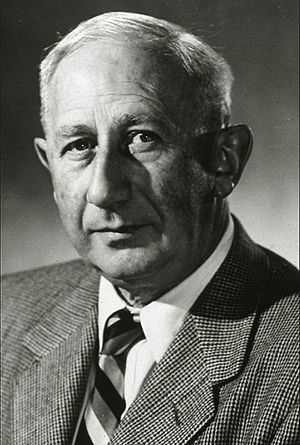Walter Baade facts for kids
Quick facts for kids
Walter Baade
|
|
|---|---|
 |
|
| Born | March 24, 1893 Schröttinghausen, German Empire
|
| Died | June 25, 1960 (aged 67) |
| Nationality | German |
| Citizenship | German |
| Alma mater | University of Göttingen |
| Known for | Coined the term "supernova" and "neutron star" with Fritz Zwicky |
| Awards | Bruce Medal 1955 |
| Scientific career | |
| Fields | Astronomy |
| Institutions | Hamburg-Bergedorf Observatory, Mt. Wilson, Palomar Observatory |
| Doctoral students | Halton Arp Allan Sandage |
Wilhelm Heinrich Walter Baade (born March 24, 1893 – died June 25, 1960) was a German astronomer. He worked in the United States for many years, from 1931 to 1959. He made important discoveries about stars and how big the universe is.
Contents
Walter Baade's Life and Discoveries
Walter Baade was the son of a teacher. He finished school in 1912. He then studied math, physics, and astronomy. He went to the Universities of Münster and Göttingen.
After getting his PhD in 1919, Baade worked at the Hamburg Observatory in Germany. This was from 1919 to 1931. In 1920, he found 944 Hidalgo. This was the first of a new group of small planets called Centaurs. These Centaurs cross the paths of giant planets like Jupiter and Saturn.
Working at Mount Wilson Observatory
From 1931 to 1958, Baade worked at the Mount Wilson Observatory in the United States. During World War II, cities had "blackouts." This meant lights were turned off at night. This greatly reduced light pollution (bright city lights making it hard to see stars).
Because of this, Baade could see stars in the center of the Andromeda Galaxy for the first time. These observations helped him understand that stars belong to different "populations." He called them Population I and Population II.
Doubling the Universe's Size
His observations also led him to find two types of Cepheid variable stars. These stars change brightness in a regular way. Scientists use them to measure distances in space.
Using this new discovery, Baade recalculated the size of the known universe. He found it was twice as big as what Hubble had calculated in 1929. He announced this amazing finding in 1952. It surprised many astronomers at a meeting in Rome.
Supernovae and Neutron Stars
Walter Baade also worked with another scientist, Fritz Zwicky. Together, they identified supernovae. Supernovae are huge, bright explosions of stars. They said these were a new type of object in space.
Zwicky and Baade also suggested that neutron stars exist. Neutron stars are super dense, tiny stars left behind after a supernova. They thought supernovae might create these neutron stars.
Discovering Asteroids and Radio Sources
Starting in 1952, Baade and Rudolph Minkowski found the visible parts of many radio sources. These are objects that give off radio waves. One example was Cygnus A.
Baade discovered 10 asteroids in total. This includes 944 Hidalgo, which has a very long path around the Sun. He also found 1566 Icarus, an Apollo-class asteroid. Its closest point to the Sun is even nearer than Mercury's path. Another asteroid he found was 1036 Ganymed, which is an Amor-type asteroid.
Awards and Things Named After Him
| 930 Westphalia | March 10, 1920 |
| 934 Thüringia | August 15, 1920 |
| 944 Hidalgo | October 31, 1920 |
| 966 Muschi | November 9, 1921 |
| 967 Helionape | November 9, 1921 |
| 1036 Ganymed | October 23, 1924 |
| 1103 Sequoia | November 9, 1928 |
| 1566 Icarus | June 27, 1949 |
| 5656 Oldfield | October 8, 1920 |
| 7448 Pöllath | January 14, 1948 |
Awards
- Foreign membership of the Royal Netherlands Academy of Arts and Sciences (1953)
- Gold Medal of the Royal Astronomical Society (1954)
- Bruce Medal (1955)
- Henry Norris Russell Lectureship of the American Astronomical Society (1958)
Named after him
- The Asteroid 1501 Baade
- The crater Baade on the Moon
- Vallis Baade, a valley on the Moon
- One of the two Magellan telescopes
- The asteroid 966 Muschi, named after his wife's nickname
See also
 In Spanish: Walter Baade para niños
In Spanish: Walter Baade para niños

